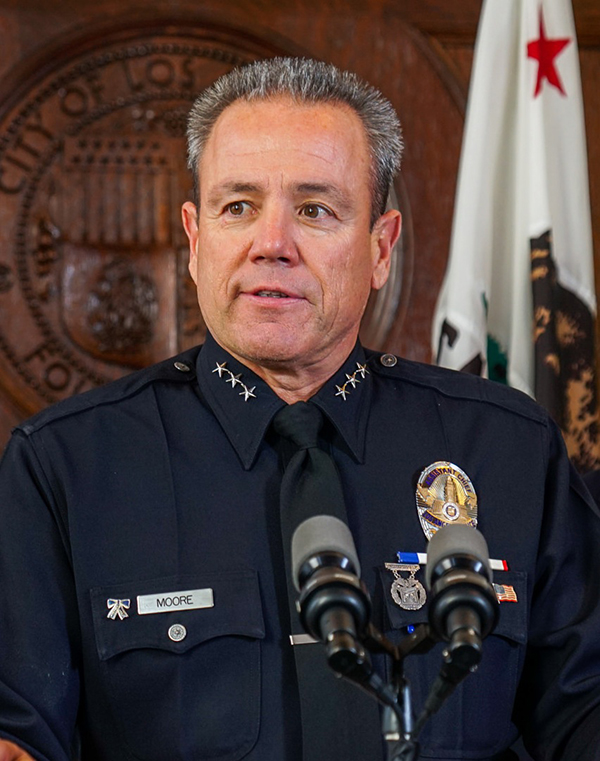Wave Wire Services
LOS ANGELES — In response to the death of Keenan Anderson in January, and concerns regarding the Los Angeles Police Department’s use of “less-lethal” force, the Police Commission Aug. 22 approved revisions to the department’s policies regarding the use of stun guns.
The Board of Police Commissioners voted unanimously to move forward with a proposal to rename and revise policy pertaining to the use of stun guns and other “less-lethal control devices,” or what will now be called “use of intermediate force options.”
Assistant Police Chief Dominic Choi said recent uses of “less-lethal control devices” prompted a “need to really look at the intermediate use of force policy and Taser use policy.”
Under department policy, officers are allowed to use a stun gun, baton, beanbag shotgun, 40mm less-lethal launcher or chemical agents such as pepper spray when there is an immediate threat to the safety of the officers or others.
A sentence was added to the policy Aug. 22: “If the threat is not immediately addressed, there is an articulable risk the incident could escalate to the use of deadly force.”
“The sentence was added to allow officers more time from the point where they could first use an intermediate force option to when they could use a lethal force option,” Choi said.
Choi said in multiple incidents in the recent past, officers deployed less lethal force options and lethal force options simultaneously. The change in this policy will “change those circumstances or lessen those occurrences,” he added.
As it relates to the use of stun guns, the commission revised the policy to include “Department personnel shall not administer a Taser using the drive-stun method (excluding three-point and four-point drive-stun) to any subject or suspect, unless articulable circumstances exist justifying the need for drive-stun mode.”
According to Police1, an online resource for law enforcement agencies, stun guns have a “probe” mode and a “drive-stun” mode. The drive-stun mode is considered by law enforcement agencies to be a “pain-compliance” technique and used on resisting or assaulting subjects.
The drive-stun mode only causes a localized pain compliance and is less effective than the protocol — and can likely lead to other use of force tactics or methods to subdue a suspect.
“This policy provides an allowance for officers to use the drive-stun mode in specific circumstances,” Choi said. “What we’re trying to do is create options for officers to be able to deploy less lethal force before they have to resort to lethal force.”
Rasha Shields, vice president of the commission, said she was supportive of the policy changes and believed that it will reduce the risk of deadly use of force, as needed. She emphasized the policy change is intended as a measure in the likelihood that a suspect is armed with a weapon.
LAPD Chief Michel Moore also said the department will be bringing proposals within a few weeks to purchase several stun guns and implement a pilot program to test and evaluate the device.
Moore said the new devices, developed by Axon, will not have a drive-stun mode and will shoot single darts, making it easier to hit a target.
“I think this is going to achieve what Mayor Karen Bass has tasked us with as well, which is in the aftermath of these events, including the death of Keenan [Anderson].” Moore said. “The coroner’s office found Tasers were not the cause of his death but nonetheless to the public view.
Relatives of Anderson, a Black man who went into cardiac arrest and died after being shot with a stun gun multiple times in a struggle with Los Angeles police in Venice, filed a lawsuit against the city.
Anderson, the father of a 5-year-old son, had been a teacher for more than eight years, the final six months at Digital Pioneers Academy, a charter high school in Washington, D.C. The 31-year-old Anderson had been in the Los Angeles area visiting relatives during the holidays when he got into the Jan. 3 confrontation with police following a minor traffic collision near Lincoln and Venice boulevards.
Attorneys said police used a stun gun on Anderson six times, causing his heart to later flutter and ultimately fail. He died hours later at a hospital.
A subsequent autopsy determined that Anderson died from the effects of an enlarged heart and cocaine use.
Los Angeles attorney Carl Douglas, representing Anderson’s family along with famed national civil rights attorney Ben Crump, previously acknowledged the drug use, but said it doesn’t justify officers’ actions.
The Los Angeles Superior Court lawsuit alleges civil rights violations, assault and battery, false imprisonment and negligence.
The suit seeks unspecified damages, although attorneys said they would ask for damages of $100 million. The family had earlier filed a required damages claim against the city seeking $50 million, but it was rejected.
Anderson was one of three men who died in confrontations with the LAPD during the first three days of the year. The two other men were fatally shot. The deaths prompted a series of protests, demands for the ouster of Moore and calls for changes in the way the agency responds to traffic crashes.









